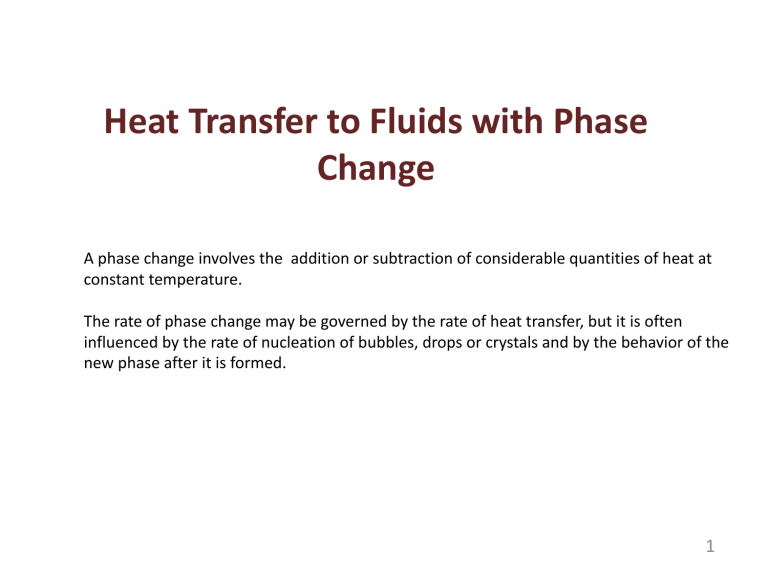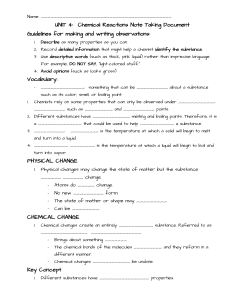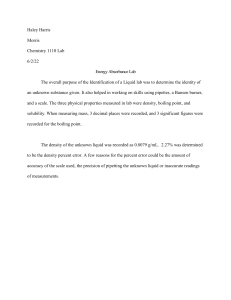
Heat Transfer to Fluids with Phase Change A phase change involves the addition or subtraction of considerable quantities of heat at constant temperature. The rate of phase change may be governed by the rate of heat transfer, but it is often influenced by the rate of nucleation of bubbles, drops or crystals and by the behavior of the new phase after it is formed. 1 Boiling Heat Transfer • Evaporation occurs at the liquid–vapor interface when the vapor pressure is less than the saturation pressure of the liquid at a given temperature. • Boiling occurs at the solid–liquid interface when a liquid is brought into contact with a surface maintained at a temperature sufficiently above the saturation temperature of the liquid Classification of Pool Boiling boiling • Boiling is called pool boiling in the absence of bulk fluid flow. • Any motion of the fluid is due to natural convection currents and the motion of the bubbles under the influence of buoyancy. Flow Boiling • Boiling is called flow boiling in the presence of bulk fluid flow. • In flow boiling, the fluid is forced to move in a heated pipe or over a surface by external means such as a pump. Classification of boiling Subcooled Boiling • When the temperature of the main body of the liquid is below the saturation temperature. Saturated Boiling • When the temperature of the liquid is equal to the saturation temperature. Pool Boiling Boiling takes different forms, depending on the ΔTexcess=Ts-Tsat Natural Convection (to Point A on the Boiling Curve) • Bubbles do not form on the heating surface until the liquid is heated a few degrees above the saturation temperature (about 2 to 6°C for water) the liquid is slightly superheated in this case (metastable state). • The fluid motion in this mode of boiling is governed by natural convection currents. • Heat transfer from the heating surface to the fluid is by natural convection. Nucleate Boiling • The bubbles form at an increasing rate at an increasing number of nucleation sites as we move along the boiling curve toward point C. • Region A–B ─isolated bubbles. • Region B–C ─ numerous continuous columns . of vapor in the liquid Nucleate Boiling • In region A–B the stirring and agitation caused by the entrainment of the liquid to the heater surface is primarily responsible for the increased heat transfer coefficient. • In region A–B the large heat fluxes obtainable in this region are caused by the combined effect of liquid entrainment and evaporation. • After point B the heat flux increases at a lower rate with increasing ΔTexcess, and reaches a maximum at point C. • The heat flux at this point is called the critical (or maximum) heat flux, and is of prime engineering importance. Transition Boiling • When ΔTexcess is increased past point C, the heat flux decreases. • This is because a large fraction of the heater surface is covered by a vapor film, which acts as an insulation. • In the transition boiling regime, both nucleate and film boiling partially occur. Film Boiling • Beyond Point D the heater surface is completely covered by a continuous stable vapor film. • Point D, where the heat flux reaches a minimum is called the Leidenfrost point. • The presence of a vapor film between the heater surface and the liquid is responsible for the low heat transfer rates in the film boiling region. • The heat transfer rate increases with increasing excess temperature due to radiation to the liquid. Burnout Phenomenon • A typical boiling process does not follow the boiling curve beyond point C. C E • When the power applied to the heated surface exceeded the value at point C even slightly, the surface temperature increased suddenly to point E. • When the power is reduced the coolingstarting curve follows Fig.Ewith a sudden drop gradually from point in excess temperature when point D is reached. D Heat Transfer Correlations in Pool Boiling • Boiling regimes differ considerably in their character different heat transfer relations need to be used for different boiling regimes. • In the natural convection boiling regime heat transfer rates can be accurately determined using natural convection relations. Heat Transfer Correlations in Pool Boiling ─ Nucleate Boiling • No general theoretical relations for heat transfer in the nucleate boiling regime is available. • Experimental based correlations are used. • The rate of heat transfer strongly depends on the nature of nucleation and the type and the condition of the heated surface. • A widely used correlation proposed in 1952 by 1/2 ⎤ Rohsenow: ⎡g ρ − ⎛ c ⎢ ρ " qs = l μ hfg ⎢⎣ () l σ v ⎥ ⎥ ⎞ e ΔT ⎜ ⎥n C s , f hfg l ⎠ ⎦ ⎝ Pr p,l 3 Heat Transfer Correlations in Pool Boiling ─ Nucleate Boiling • The values in Rohsenow equation can be used for any geometry since it is found that the rate of heat transfer during nucleate boiling is essentially independent of the geometry and orientation of the heated surface. • The correlation is applicable to clean and relatively smooth surfaces. • Error for the heat transfer rate for a given excess temperature: 100%. • Error for the excess temperature for a given heat transfer rate for the heat transfer rate and by 30%. Critical Heat Flux (CHF) • The maximum (or critical) heat flux in nucleate pool boiling was determined theoretically by S. S. Kutateladze in Russia in 1948 and N. Zuber in the United States in 1958 to be: " qmax =fgCh ρ ⎡σ g ρ l − ρv ⎤ 2 ⎥ ρ ⎢⎣ ⎦ v ⎥ ( ) v 1 4 ⎢ C is a constant whose value depends on the heater geometry, but generally is about 0.15. • The CHF is independent of the fluid–heating surface combination, as well as the viscosity, thermal conductivity, and the specific heat of the liquid. • The CHF increases with pressure up to about one-third of the critical pressure, and then starts to decrease and becomes zero at the critical pressure. • The CHF is proportional to hfg, and large maximum heat fluxes can be obtained using fluids with a large enthalpy of vaporization, such as water. Minimum Heat Flux • Minimum heat flux, which occurs at the Leidenfrost point, is of practical interest since it represents the lower limit for the heat flux in the film boiling regime. • Zuber derived the following expression for the minimum heat flux for a large horizontal plate 4 " min q ⎡ ⎤ = 0.09ρ vh ⎢σ g ⎥ ρl − ρ2v 1 ⎢ ρ + ⎥ l v ⎣ ⎦ fg ρ ( () ) • the relation above can be in error by 50% or more. Film Boiling • The Nusselt number for film boiling on a horizontal cylinder or sphere of diameter D is given by 1/4 C = 0.62 (cylinder) ⎡ D3 ⎤ g lρ −v ρ fg , = C ⎢ ⎥ v k (T −v T v) s C = 0.67 (sphere) v ⎢ ⎥ ⎣ ' ⎦ sat h • At high surface temperatures (typically above 300°C), heat h Nu D Dconv = k ( ) transfer across the vapor film by radiation becomes significant and needs to be considered. • The two mechanisms of heat transfer (radiation and convection) adversely affect each other, causing the total heat transfer to be less than their sum. 4/3 h =h 4/3 conv + hrad h 1/3 , h = rad () εσ T s4− sat T4 Ts − T sat Enhancement of Heat Transfer in Pool Boiling • The rate of heat transfer in the nucleate boiling regime strongly depends on the number of active nucleation sites on the surface, and the rate of bubble formation at each site. • Therefore, modification that enhances nucleation on the heating surface will also enhance heat transfer in nucleate boiling. • Irregularities on the heating surface, including roughness and dirt, serve as additional nucleation sites during boiling. • The effect of surface roughness is observed to decay with time. Enhancement of Heat Transfer in Pool Boiling • Surfaces that provide enhanced heat transfer in nucleate boiling permanently are being manufactured and are available in the market. • Heat transfer can be enhanced by a factor of up to 10 during nucleate boiling, and the critical heat flux by a factor of 3. Thermoexcel-E External Forced Convection Boiling (Flow Boiling) • In flow boiling, the fluid is forced to move by an external source such as a pump as it undergoes a phase-change process. • The boiling in this case exhibits the combined effects of convection and pool boiling. • Flow boiling is classified as either external and internal flow boiling. • External flow ─ the higher the velocity, the higher the nucleate boiling heat flux and the critical heat flux. Axial position in the tube Flow Boiling ─ Internal Flow • The two-phase flow in a tube exhibits different flow boiling regimes, depending on the relative amounts of the liquid and the vapor phases. • Typical flow regimes: – – – – – – Liquid single-phase flow, Bubbly flow, Slug flow, Annular flow, Mist flow, Vapor single-phase flow. Flow Boiling ─ Internal Flow • Liquid single-phase flow – In the inlet region the liquid is subcooled and heat transfer to the liquid is by forced convection (assuming no subcooled boiling). • Bubbly flow – Individual bubbles – Low mass qualities • Slug flow – Bubbles coalesce into slugs of vapor. – Moderate mass qualities • Annular flow – Core of the flow consists of vapor only, and liquid adjacent to the walls. – Very high heat transfer coefficients • Mist flow – a sharp decrease in the heat transfer coefficient • Vapor single-phase flow – The liquid phase is completely evaporated and vapor is superheated. Water is to be boiled at atmospheric pressure in a mechanically polished stainless steel pan placed on top of a heating unit, as shown in Figure . The inner surface of the bottom of the pan is maintained at 108°C. If the diameter of the bottom of the pan is 30 cm, determine (a) the rate of heat transfer to the water and (b) the rate of evaporation of water. Condensation • Condensation occurs when the temperature of a vapor is reduced below its saturation temperature. • Only condensation on solid surfaces is considered in this chapter. • Two forms of condensation: – Film condensation, – Dropwise condensation. Condensation: Physical Mechanisms Film condensation Dropwise condensation • The condensate wets the • The condensed vapor forms surface and forms a liquid droplets on the surface. film. • The surface is blanketed by • The droplets slide down when they reach a certain a liquid film which serves size. as a resistance to heat transfer. • No liquid film to resist heat transfer. • As a result, heat transfer rates that are more than 10 times larger than with film condensation can be achieved. Film Condensation on a Vertical Plate • liquid film starts forming at the top of the plate and flows downward under the influence of gravity. • The thickness of the film δ increases in the flow direction x • Heat in the amount hfg is released during condensation and is transferred through the film to the plate surface. • Ts must be below the saturation temperature for condensation. • The temperature of the condensate is T at the interface and decreases Vertical Plate ─ Flow Regimes • The dimensionless parameter controlling the transition between regimes is the Reynolds number defined as: hydraulic diameter ⏞ Rex = (Dh ) 4δ ( ) μ ρlum l • Three prime flow regimes: – Re<30 ─ Laminar (wave-free), – 30<Re<1800 ─ Wavy-laminar, – Re>1800 ─ Turbulent. • The Reynolds number increases in the flow direction. Heat Transfer Correlations for Film Condensation ─ Vertical wall Assumptions: 1. Both the plate and the vapor are maintained at constant temperatures of Ts and Tsat, respectively, and the temperature across the liquid film varies linearly. 2. Heat transfer across the liquid film is by pure conduction. 3. The velocity of the vapor is low (or zero) so that it exerts no drag on the condensate (no viscous shear on the liquid–vapor interface). 4. The flow of the condensate is laminar (Re<30) and the properties of the liquid are constant. 5. The acceleration of the condensate layer is negligible. Height L and width b




